Table of Contents
Key Findings of Human Disturbance on Wildlife
- Species interactions: Landscape changes induced by human activities may disrupt invisible facets of biodiversity such as species interactions.
- Interspecies encounters: Human disturbance compresses the spatiotemporal niche of wildlife, leading to more interspecies encounters.
- This interspecies squeeze could have effects such as making it harder for prey to evade predators, intensifying competition for resources or increasing the risk of interspecies disease transmission, the researchers say.
- Changes in ecosystem functions: Human disturbances can change the interactions between species, which can alter the way an ecosystem functions.
- For example, changes in predator-prey relationships can affect the way energy flows through an ecosystem.

What other ways can Human Disturbance Affect Wildlife?
- Habitat loss: Human activities such as logging, farming, urbanization, and mining can lead to habitat loss, making it difficult or impossible for animals to survive in those areas.

- Pollution: Human-generated pollution, such as chemical spills, industrial waste, and plastic debris, can contaminate habitats and make it difficult or impossible for animals to survive.
- Climate change: Human activities such as burning fossil fuels and deforestation can contribute to climate change, which can alter habitats and disrupt the routines of animals.
- Noise pollution: Human activities such as construction, transportation and industrial activity can generate excessive noise, which can disrupt the communication and mating patterns of animals.
- Light pollution: Artificial light at night from human activities can interfere with the natural light cycle of animals, disrupting their feeding, migration and breeding patterns.
- Human interference: Direct human interference such as hunting, poaching, and fishing can disrupt the routines of animals and can cause direct harm.
- Introduction of invasive species: Human activities such as transportation and trade can lead to the introduction of invasive species into new areas, which can out compete and displace native wildlife


 UPSC EPFO Result 2025 Out: EO/AO and APF...
UPSC EPFO Result 2025 Out: EO/AO and APF...
 TNPSC Group 2 Main Exam List 2025 Releas...
TNPSC Group 2 Main Exam List 2025 Releas...
 TNPSC Group 2 Result 2025 Out: Check Mar...
TNPSC Group 2 Result 2025 Out: Check Mar...

























